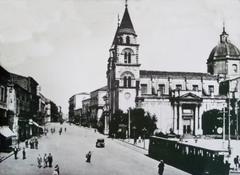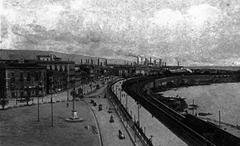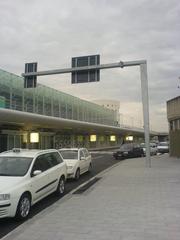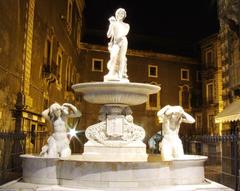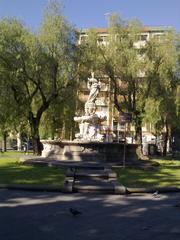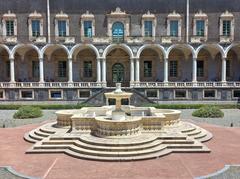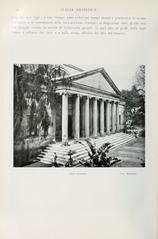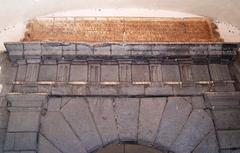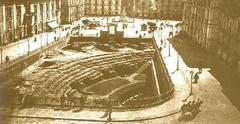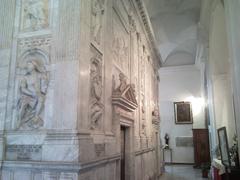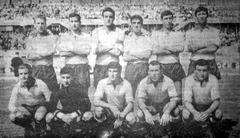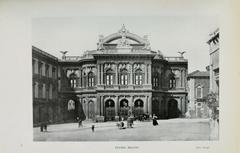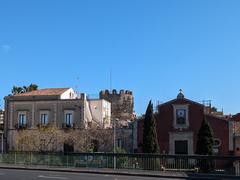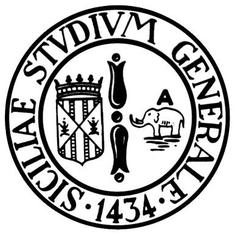
Terme Achilliane: Visiting Hours, Tickets, and History Guide in Catania
Date: 04/07/2025
Introduction
Beneath the bustling Piazza del Duomo, at the very heart of Catania, Sicily, lies one of the city’s most intriguing archaeological treasures—the Terme Achilliane. These remarkable Roman baths, dating from the 3rd to 5th centuries CE, offer a unique glimpse into the advanced engineering, artistic sophistication, and vibrant social life of ancient Roman Catania. Preserved beneath the Baroque Cathedral of Sant’Agata, the baths reveal the city’s layered history, shaped by centuries of urban development and natural disasters. This comprehensive guide provides all the essential information about Terme Achilliane visiting hours, tickets, accessibility, guided tours, and practical travel tips. You’ll also find a detailed exploration of the site’s historical and architectural significance, making this the perfect resource for anyone planning to visit this exceptional Roman landmark (Comune di Catania; Visit Catania; PeriPeriCatania).
Table of Contents
- Introduction
- Origins and Construction
- Architectural Layout and Features
- Social and Cultural Role in Roman Catania
- The Name “Achilliane” and Epigraphic Evidence
- Discovery, Conservation, and Modern Access
- Visiting Information: Hours, Tickets, and Accessibility
- Travel Tips and Practical Advice
- Nearby Attractions
- Frequently Asked Questions (FAQ)
- Conclusion and Call to Action
- References
1. Origins and Construction
The Terme Achilliane were constructed in the late Imperial Roman era, primarily between the 3rd and 5th centuries CE (Comune di Catania PDF; Museionline). Built during a period of significant urban development, the baths were strategically located near the ancient shoreline and were supplied by the Amenano River—a crucial element in their operation (PeriPeriCatania). While the exact year of construction is debated, architectural analyses suggest multiple phases and continued use into the 4th and 5th centuries.
2. Architectural Layout and Features
Main Hall and Corridors
The most notable surviving structure is a large, rectangular hall (approx. 12 x 13 meters), supported by four massive pillars and covered by a cross vault (Visit Catania; Sicile-Sicilia). Visitors descend through a barrel-vaulted corridor, which was constructed between the Roman structures and the cathedral’s foundations.
Water Management and Heating
The baths feature remnants of an advanced water system, with tanks and channels fed by the Amenano groundwater (Around Catania). A hypocaust heating system—an innovation of Roman engineering—was used to warm the floors and walls in the tepidarium and other areas, circulating hot air beneath suspended floors (PeriPeriCatania).
Decorative Elements
The original stucco decorations included human figures, animals, and grapevines—motifs now preserved at the Hermitage Museum, St. Petersburg (Comune di Catania PDF). These elements reflect the baths’ artistic richness and the Roman penchant for integrating art into public architecture.
3. Social and Cultural Role in Roman Catania
Roman baths were multifaceted spaces, serving not just for hygiene but as centers of socialization, leisure, and even business transactions (PeriPeriCatania). The Terme Achilliane likely included areas such as the apodyterium (dressing room), frigidarium (cold room), caldarium (hot room), and other specialized spaces, mirroring the complexity of Roman social life (Italy This Way). The integration of gymnasia and steam baths, influenced by Greek and Egyptian traditions, underscores the cosmopolitan nature of Roman Catania.
4. The Name “Achilliane” and Epigraphic Evidence
The baths’ name derives from a 5th-century CE marble inscription, discovered in several fragments and now housed in the Museo Civico at Castello Ursino (Museionline; Visit Catania). The precise meaning of “Achilliane” remains uncertain, possibly referring to a dedication or notable figure.
5. Discovery, Conservation, and Modern Access
After centuries of burial—especially due to the 1669 eruption of Mount Etna and the 1693 earthquake—the Terme Achilliane were rediscovered and partially excavated in the 18th century by Prince Ignazio Paternò Castello (PeriPeriCatania). Today, only a portion of the baths is accessible, with much still buried beneath the city. Current conservation is managed in collaboration with the Museo Diocesano, ensuring both preservation and public engagement (Museo Diocesano Catania).
6. Visiting Information: Hours, Tickets, and Accessibility
Visiting Hours
- Standard Opening: Tuesday to Sunday, typically from 9:00 AM to 1:00 PM (last entry at 12:30 PM). Closed on Mondays and public holidays.
- Seasonal Variations: Always check the Museo Diocesano website or Catania tourism portal for up-to-date information.
Tickets
- Standard Admission: Around €5 for adults.
- Discounts: Reduced rates for students, seniors, and free entry for children under 18 and residents of Catania.
- Combined Tickets: Often available with access to the Museo Diocesano.
Accessibility
- The baths are underground with stairs and uneven surfaces. Limited accessibility for wheelchair users or those with severe mobility issues. Contact the museum in advance for assistance.
Guided Tours
- Conducted via the Museo Diocesano, usually in Italian and English. Advance booking is recommended, especially during peak season.
7. Travel Tips and Practical Advice
- Footwear: Wear comfortable, non-slip shoes.
- Clothing: Bring a light jacket; the underground environment is cooler than the city above.
- Photography: Allowed, but flash and tripods may be restricted.
- Timing: Early morning visits are less crowded.
- Language: English tours are often available; other languages may require advance booking.
- Duration: Visits typically last 30–45 minutes.
8. Nearby Attractions
- Catania Cathedral (Sant’Agata): Right above the baths.
- Piazza del Duomo: Including the Elephant Fountain and Amenano Fountain.
- Museo Diocesano: Offers deeper insights into Catania’s religious and artistic history.
- Castello Ursino: Houses the Achilliane inscription.
- Roman Amphitheatre, Fish Market, and Via Etnea: All within easy walking distance.
9. Frequently Asked Questions (FAQ)
Q: What are the Terme Achilliane visiting hours?
A: Tuesday to Sunday, typically 9:00 AM–1:00 PM. Always check official sources for updates.
Q: How much do tickets cost?
A: Standard tickets are about €5, with discounts for students, seniors, and free entry for children and residents.
Q: Is the site accessible for people with disabilities?
A: Accessibility is limited due to stairs and uneven floors. Contact the museum for specific arrangements.
Q: Are guided tours available in English?
A: Yes, especially during high season; advance booking is recommended.
Q: Can I take photographs inside?
A: Photography is allowed, but flash/tripods may be restricted.
10. Conclusion and Call to Action
The Terme Achilliane stand as a testament to the ingenuity, artistry, and cultural vibrancy of ancient Roman Catania. Their vaulted halls, advanced water systems, and decorative fragments offer visitors a compelling journey beneath the city’s modern streets. With practical visiting hours, affordable tickets, and a central location, the baths are an essential stop on any itinerary of Catania historical sites.
To enhance your visit, download the Audiala app for guided audio tours and insider tips. For the latest events, opening times, and travel advice, follow us on social media and consult the official tourism websites.
11. References and Further Reading
- Terme Achilliane: Visiting Hours, Tickets, and Historical Insights of Catania’s Roman Baths, 2025, Comune di Catania (https://www.comune.catania.it/la-citta/turismo/monumenti-and-musei-itinerari-turistici/imghome/29-terme-achilliane.pdf)
- Terme Achilliane, 2025, Visit Catania (https://www.visitcatania.co/en/things-to-do/itineraries/catania-underground/terme-achilliane/)
- Le Terme Achilliane, 2025, PeriPeriCatania (https://www.peripericatania.it/cosa-vedere/le-terme-achilliane/)
- Terme Achilliane, 2025, Museo Civico Castello Ursino (https://museionline.info/tipologie-museo/terme-achilliane)
- Terme Achilliane, 2025, Enjoy Sicilia (https://www.enjoysicilia.it/en/catania-etna-area//catania/terme-achilliane-a-catania/)
- Terme Achilliane, 2025, Around Catania (https://www.aroundcatania.it/en/places/achilliane-baths)
- Terme Achilliane Visitor Information, 2025, Museo Diocesano Catania (https://museodiocesanocatania.com/page/it-IT/4/le-terme-achilliane)
- Terme Achilliane, 2025, Turismo Comune di Catania (https://turismo.comune.catania.it/scoprire-catania/patrimonio-monumentale/terme-achilliane.aspx)
- Terme Achilliane, 2025, Spotting History (https://www.spottinghistory.com/view/10381/terme-achilliane/)
- Terme Achilliane, 2025, Italy This Way (https://www.italythisway.com/places/catania.php)


